Join Jennifer Wheeler as she shares real-life stories from the field about the challenges of saving the endangered Black-capped Petrel, aka Diablotin, from extinction. You might laugh, you might cry, you might want to join the project. Hopefully you’ll feel as inspired as we are about the future of this species, thanks to the hard work of many organizations and people.
Only a very small number of people on the planet can say they have had close contact with a Black-capped Petrel. This mid-sized seabird comes to land only to breed, only at night under cover of darkness, and often heads quickly out of sight into underground burrows. This covert behavior as well as the species’ eerie, wailing vocalizations in the night sky, earned it the name Diablotin (“little devil”) from early European and African arrivals to the Caribbean. It was the birds that should have been afraid: human settlement of the Caribbean, accompanied by the introduction of invasive mammals, reduced the Diablotin from abundant on many Caribbean islands to widely considered extinct by the early 1900s.
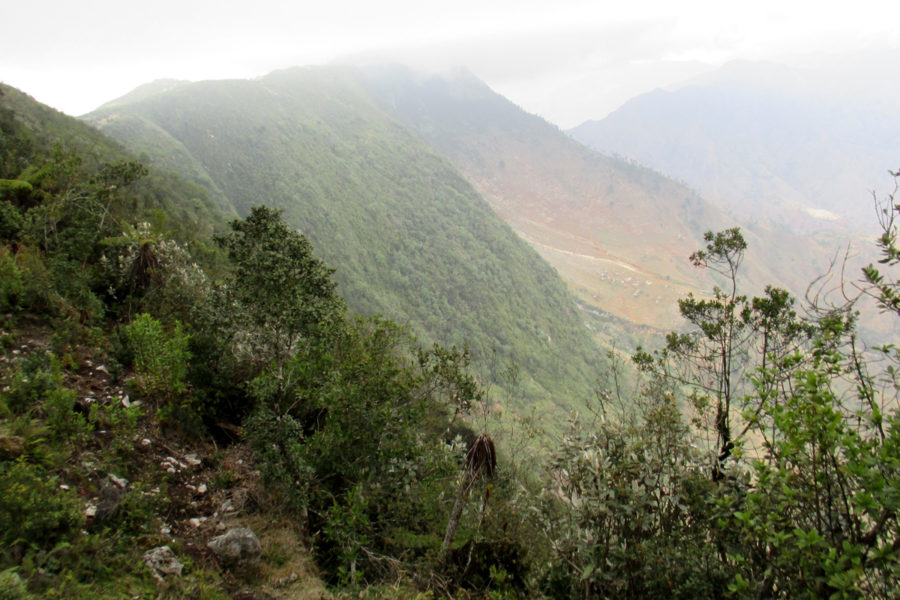
I’ve been cheerleading and coordinating conservation of the Diablotin for a decade, working with numerous partners in the International Black-capped Petrel Conservation Group. The species turns out not to be extinct but very rare. It is listed as Endangered on the IUCN Red List of Threatened Species and the total world population is estimated at no more than 1,000 breeding pairs. Only about a hundred Diablotin burrows have been located to date, all on the island of Hispaniola (Haiti and the Dominican Republic). It’s actually much easier to see a Diablotin out at sea than find one inland.
My first encounter with the species was in 2009. I saw them zipping by at a distance over the open ocean from the Stormy Petrel, a seabirding tour boat operating out of Cape Hatteras, North Carolina. Though the Diablotin’s breeding range is limited to the Caribbean, it turns out that they concentrate in a foraging area off the southeast U.S. To observe them at sea, one needs to be out over deep marine waters near or in the Florida Current and Gulf Stream, and that is most easily done where the Outer Banks protrude into the Atlantic. In the subsequent years, I got no closer, and I certainly wasn’t one of the group of people that could say they had touched a Diablotin, seen one up close, or even smelled their fishy body odor. Last year, I decided it was time to change that.
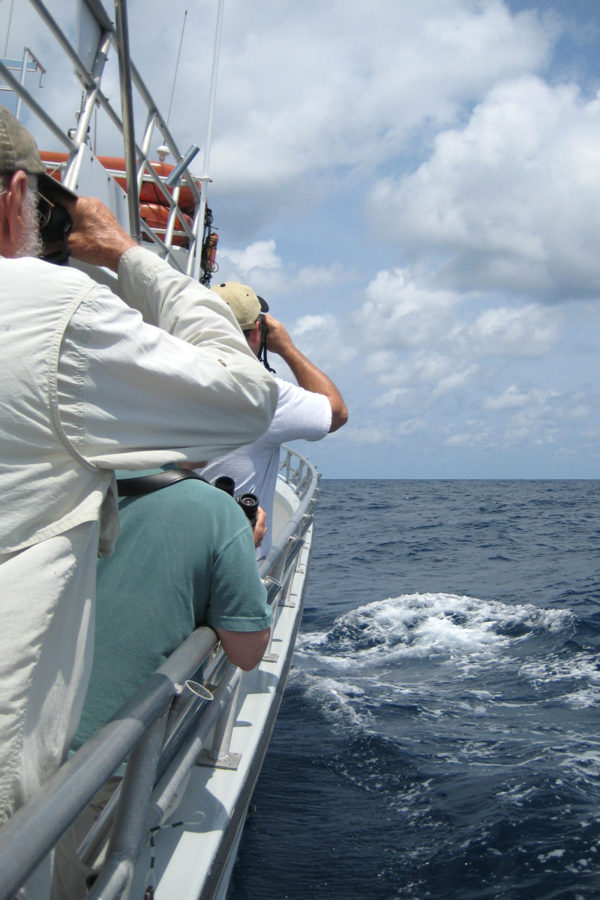
Hoping for Haiti
In April 2019 I planned on experiencing the Diablotin first-hand on a trip to Haiti. This is the country where most of those one hundred burrows are known to occur. In fact, it was in Haiti that they were re-discovered on a mountain ridge in 1961, after being lost to science for decades. This is miraculous considering that Haiti is one of the most deforested nations in the world, with some estimates that Haiti has retained less than 1% of its primary forest. Almost all of Haiti has been converted to agriculture or grazing, and secondary forest is degraded by wood-cutting and forest product collection. Petrels don’t need trees for nesting but trees and shrubs provide cover and root structure needed for burrow construction. Additionally, socioeconomic conditions in Haiti are so dire that people encountering these species are quite likely to consume them, which of course, is what introduced rats, cats and mongoose would like to do.
The Black-capped Petrel’s exact nesting locations in Haiti have not been easy to find. Even with the knowledge that they persisted on Haiti, it took until 2002 to locate an active burrow and until 2011 to see a living chick. Finding that little fluffball took an incredible number of hours crawling along cliffs and the forest floor, aided by information collected by radar and automated sound recording devices.
There is a small but significant nesting population of Diablotin in southwest Haiti, in a small patch of primary forest near the village of Boukan Chat. Since the discovery of the Diablotin in this area, local and international conservationists have been building relationships with the citizens of the village. Beginning with humanitarian projects, conservationists now pursue a strategy of improving farming practices and empowering local farmers to convert to more sustainable crops. More productivity on existing farmland reduces the likelihood of encroachment into the forest. Winning the hearts and minds of the local people also involves outreach, education and celebration. Foremost among these is the now annual Festival Diablotin Boukan Chat, which I had hoped to personally experience.
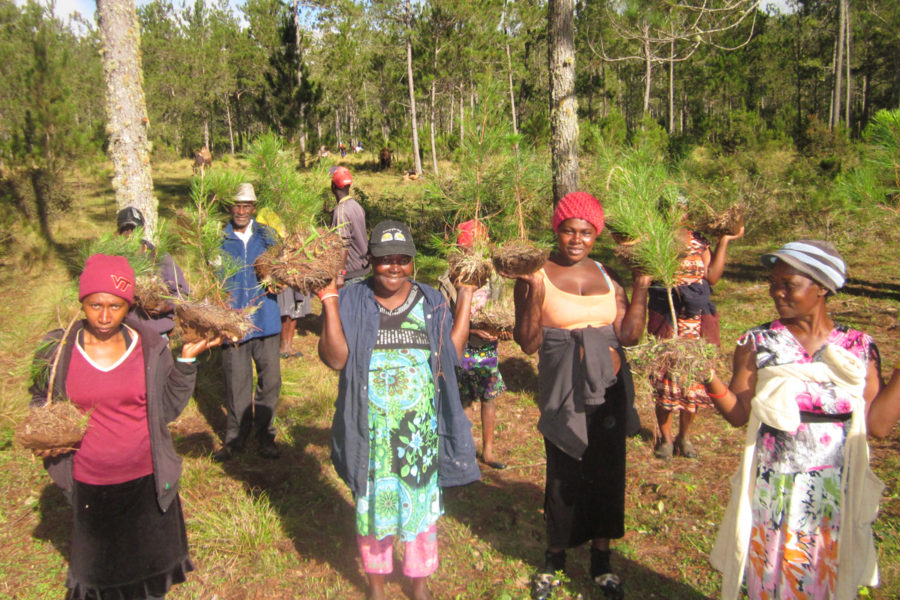
Unfortunately, 2019 was not a good year for Haiti and its people. Anti-government protests turned violent last February, with accompanying increases in crime. The U.S. State Department and other authorities advised against travel to Haiti. Environmental Protection in the Caribbean (EPIC) is the organization spearheading much of the education and outreach in Boukan Chat. Adam Brown, project leader, made the disappointing but prudent decision to cancel attendance by international festival team members, including myself.
And yet, civil unrest did not deter the local members from carrying on with the festival! Boukan Chat held a Black-capped Petrel parade with musicians, pupils, farmers, and community members from the village to the soccer pitch. The celebrations ended with a soccer match between two soccer teams, including the appropriately logo’ed Boukan Chat team, ‘The Diablotins.’ There was a nighttime screening of the short film, Haiti, My Love, My Home which tells how the villagers, conservationists and humanitarians, have come together to protect the Diablotin. EPIC just released another amazing film The Diablotin Festival, which portrays the festival and just about makes me cry every time I watch it. I sincerely hope I can attend the Diablotin Festival in-person in the future, and more importantly, that peace returns to Haiti.
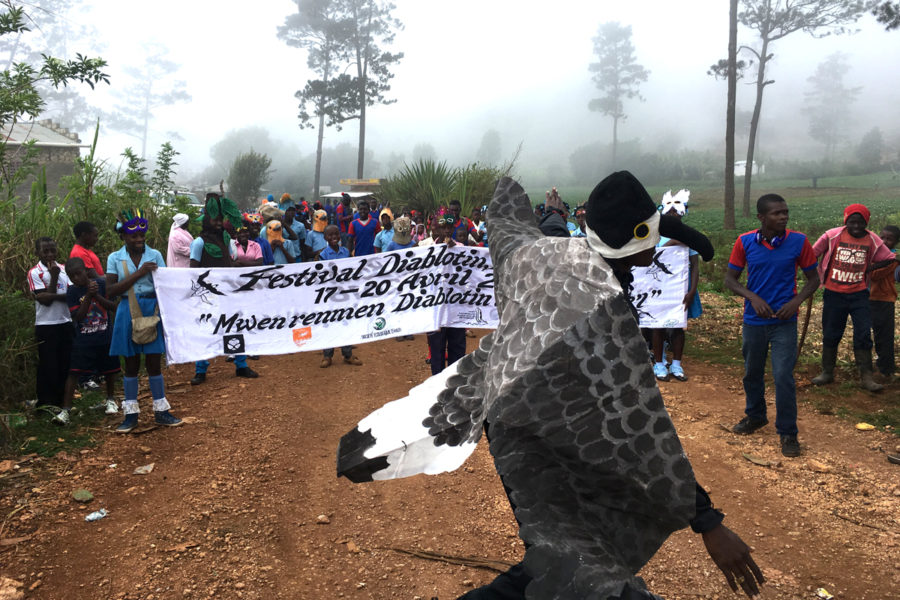
Lost (it) At Sea
May 2019 brought a new opportunity to encounter petrels. This involved another trip on the Stormy Petrel in North Carolina, but with a twist. A team would be attempting to capture petrels at sea in order to fit them with tracking devices. The goal was to learn more about Diablotin movements, and if the transmitters lasted until breeding season the following winter, track them to possibly new and unknown nesting locations. The American Bird Conservancy (ABC) invited Chris Gaskin from New Zealand and his super nifty, specially designed hand-held net launcher for the job.
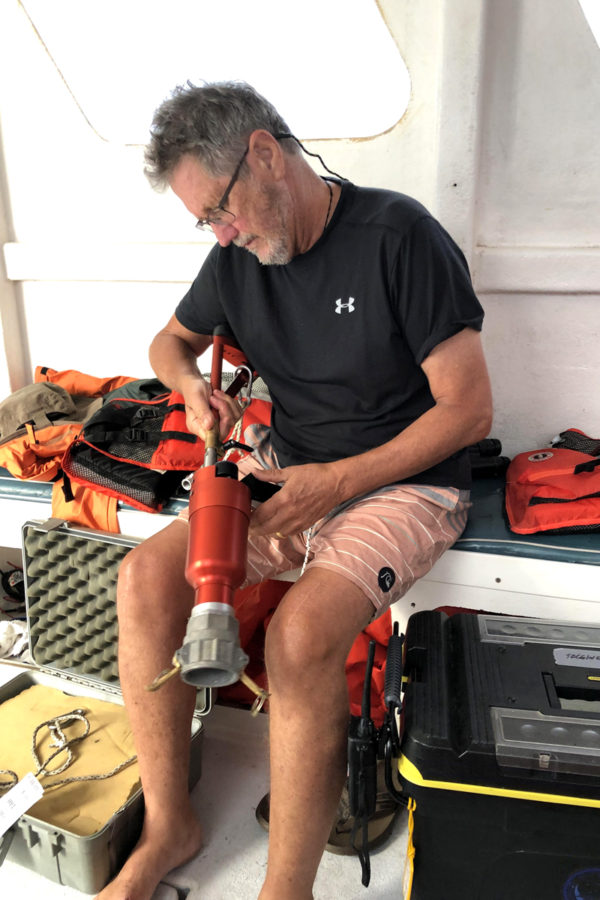
Even with this, I confess, I was a doubter. There was no way this was going to work. Petrels are fast flyers and don’t come all that near to boats. What I didn’t realize was that Chris would be shooting from a small, inflatable Zodiac, which apparently doesn’t spook petrels, especially those fixated on the smelly fish oil put out to attract them. On May 8, as I prepared to drive down to North Carolina from Virginia to join in the expedition, I received a text with an image of a flying net enfolding a Black-capped Petrel!
Turns out that the team was fantastic at catching petrels. Brian Patteson, captain of the Stormy Petrel knew where to find the birds. Brad Keitt with ABC and Pat Jodice with the U.S. Geological Survey South Carolina Coop unit at Clemson University took turns piloting the Zodiac and Chris into position. Chris never missed after his first shot. Yvan Satgé, also with Clemson, deftly fit each bird with a small solar-powered tracking device and took measurements and photos. Arriving in North Carolina, I helped celebrate the first six Diablotin ever captured at sea and I couldn’t wait to observe and assist.
The weather did not cooperate. The first day after I arrived the seas were too rough to be safe. The next day the seas were too calm; open ocean seabirds like wind. The third day was too rough again. I was out of time and actually began driving home. What was I thinking!?! An hour out I came to my senses and turned back to Hatteras to wait for good seas. Finally, on May 14, conditions looked very promising. And they were! It was so exciting to see a bird netted by Chris and watch the Zodiac speeding back to the boat to hand it over to me. And then, the dream came true: I held a living Diablotin in my hands!
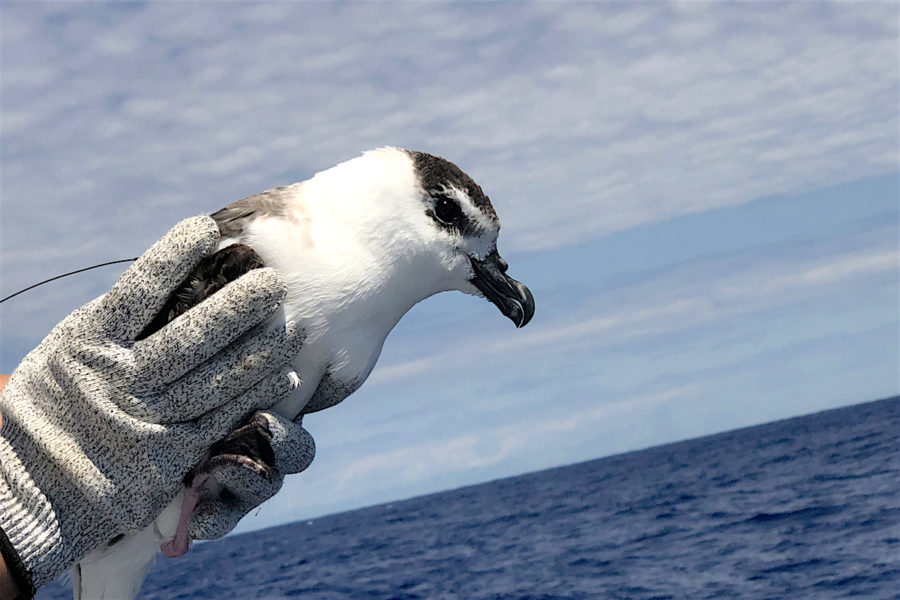
Not for long. I rushed to disentangle the net, then thrust the bird into someone else’s hands so I could rush to the side of the boat and throw up my breakfast. My big chance to handle a live Diablotin and I nearly foul its feathers with vomitus. Sigh. I was seasick for the rest of the day, providing only comic relief while the rest of the team successfully captured and fitted four more birds with satellite transmitters. Over the months to come, the birds’ movements were followed via satellite. Amazingly, the bird I almost upchucked upon was still transmitting 8 months later, longer than any other. Maybe it felt the love.
Determined in Dominica
As noted, one of the hopes of the satellite tracking was to see if any of the birds traveled to new nesting locations. Diablotin burrows have been found only on Hispaniola, but hope and evidence exists that they also persist on other islands: notably Dominica, where evidence is very strong. In 2015, radar surveys performed by EPIC picked up 900+ petrel-like targets heading in and out of the mountains of that island. Additionally, individual birds were observed through night-vision scopes during those surveys. And over many years, a handful of grounded birds have been found well inland. Following the radar surveys, technical exchanges were arranged to train and assist in ground searching. In April 2016, a team from the Dominican Republic visited Dominica; another exchange in the opposite direction took place in April 2017. Unfortunately, bad weather limited search time and no burrows were located on Dominica. Then, petrel work and just about everything else on that island was derailed when Hurricane Maria blasted Dominica in September 2017, the strongest storm in that island’s recorded history.
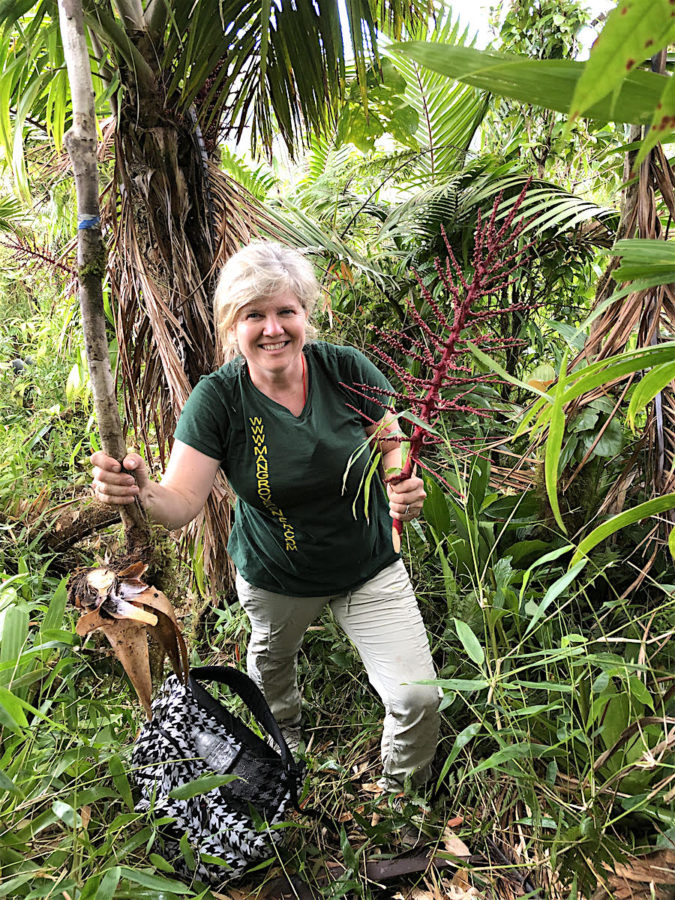
Last month, I invited myself to assist EPIC’s trip to Dominica to repeat radar surveys after five years and to help resume ground searches. Overcoming the challenges of arriving in Dominica late and alone, needing to navigate across the island’s high mountains in the dark, and driving on the “wrong” side of the road, I began to feel quite confident and helpful. I met with staff from the Division of Forestry; attended to the logistics of rental car, rental house, and groceries and obtained the heavy marine batteries needed to power the radar. My greatest success was finding a supply of small desiccant packs (those little bags of silica used to absorb moisture). I visited a dozen shops dealing with computers, appliances, and clothing, affirming that yes, I did mean those little packets that say Do Not Eat, and finally, met success at a shoe store! I was so proud. But pride goeth before the fall.
Did I mention that Dominica has really narrow roads? And it was hard to see my front left side while driving with a right side steering wheel? Fortunately, the burly body-builder was very nice about the big dent I put in his car. Repairing the suspension from shoving his car into a culvert was going to be costly though. The good news was that the damage to the rental truck was minor! You can be sure that I was relieved to turn over the driving to Adam Brown when he arrived on the ferry from Guadeloupe after two weeks of radar surveys there. And I must report that Adam often turned over the driving the really winding roads to local team members Machel Sulton and Stephen Durand. Things went smoothly after that.
We assembled the marine radar equipment and headed into the hills. Sure, setting up takes some work, but this field activity was really pleasant. We positioned ourselves on a hilltop and watched the sun set, enjoyed the cool breezes, and looked and listened for night flying creatures. Petrels appear as a distinctive pattern of blips on the radar screen. Adam would note them coming and call out for us to attempt a sighting with the night vision or thermal image scope. As was the case in 2015, the surveys detected a number of petrels at a number of locations, flying rapidly in and out of the mountains. The peak of activity commenced about 45 minutes after sunset and tapered off at about three hours. At 9 p.m. we were packing up and headed to dinner, excited about our findings but a little concerned about the drop in petrel target numbers since 2015.
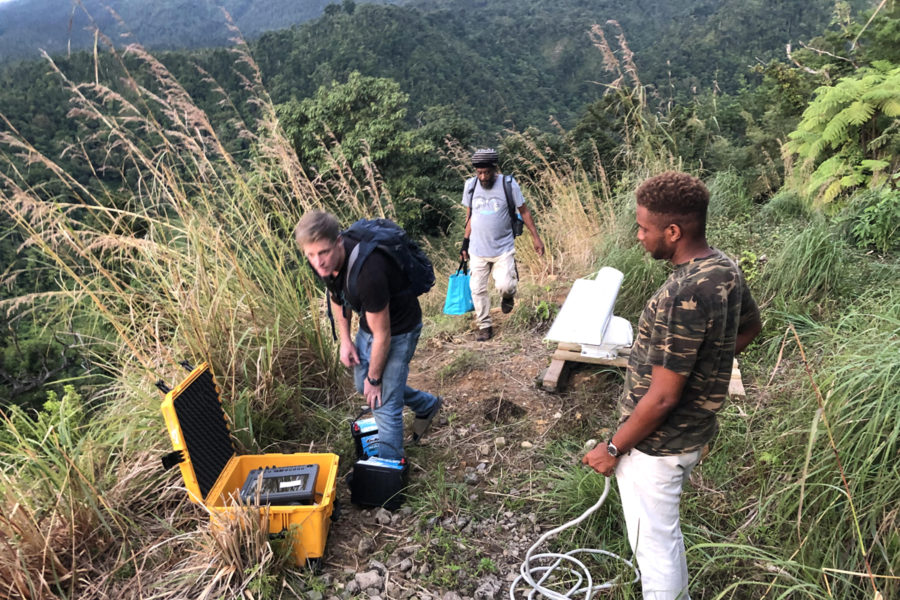
Daytime work to place soundmeters required more exertion. Radar surveys only point the way to the peaks where petrels might be nesting. Placing automated recording devices in these areas to collect any vocalizations helps narrow down the sites and seasons to search. As noted, work on Dominica to find petrels discontinued in late 2017, and the trails to the peaks selected for soundmeter placement had yet to be cleared of trees felled by hurricane and two years of new growth. Division of Forestry foresters are really very good breaking trail with machetes; regardless, it was a slow, hot hike up to the first of the selected peaks. It was certainly not unpleasant, given the varied foliage, numerous orchids and occasional songbird; but I wish we had packed more food! Once we reached higher elevations, there was the chance of finding petrel burrows so off trail into the thick, prickly underbrush we went. Crawling through the dirt, peering under roots and sniffing at holes, I fantasized about finding a burrow entrance. I’m a finder by nature—I’m happy to spend hours looking for beach glass, fossils, antiques—and I just KNEW at any moment, I would see a hole with a tell-tale plop of guano or catch a fishy whiff of petrel. What a find it would be! Alas…I did not nor did anyone else. There is still no documented nesting in Dominica since 1862.
Persistence
Now it’s February, and petrel conservationists are gearing up for field work and community-based conservation on Hispaniola. I’ve heard that the biologists in Cuba are planning an expedition into the Sierra Maestra. There will be detailed reports coming out on the surveys in Guadeloupe and Dominica, with the findings from monitoring and recommendations for continued searches. Soundmeters are placed and listening. The members of the International Black-capped Petrel Conservation Group are strategizing for the long term and seeking funds. With the Diablotin, we must be persistent. Finding the petrel is difficult; contemplating the magnitude of its threats—human population growth, habitats invaded by introduced mammals, and climate change foremost among them—can be overwhelming. But as long as there are Diablotins, there is hope.
Here’s one more story to serve as a symbol of surviving against the odds. After placing a new soundmeter in Morne Trois Pitons National Park in Dominica, we went in search of one deployed in 2017 and actually found it. It was bleached, scratched, and breached by rainwater. The tree to which it was strapped was broken and battered by the 160 mph winds of a Category 5 hurricane. It was difficult to open the unit. Yet the SD card inside survived, containing readable data. Miracles do happen.
Jennifer Wheeler is an avid adventurer and loves volunteering her time to help conservation causes. She was the coordinator of the Waterbird Council for 10 years and Board member and Treasurer of BirdsCaribbean for 8 years. She is currently co-chair of the International Black-capped Petrel Conservation Group and Financial Officer for BirdsCaribbean.
The activities noted in this article were largely supported by Seabirding/Stormy Petrel, Environmental Protection in the Caribbean, Plant with Purpose, Jeune En Action Pour La Sauvegarde De l’Ecologie En Haiti, Soulcraft All-stars, Grupo Jaragua, BirdsCaribbean (and the Betty Petersen Conservation Fund of BirdsCaribbean), American Bird Conservancy, U.S. Geological Survey South Carolina Coop unit at Clemson University, Dominica Division of Forestry, U.S. Fish and Wildlife Service, and the Disney Conservation Fund.
Please Donate!
To help save the Black-capped Petrel from extinction while also working with the people of Haiti to farm more sustainably, please donate here or here.
To view larger images in the gallery, click on each photo; they may also be viewed as a slide show.







Jennifer,
So thrilled to hear your stories.
I just get to sit here in my camp on the other side of the border in the Sierra de Bahoruco , at lower elevations,and hope the Diablotin will survive. We have a few local stories from here,
Thanks Kate! Yes, these are great stories from the field – you have so many yourself and should them up for us!!! I like to picture you at your camp; I hope to get back for a visit soon! xoxo, Lisa